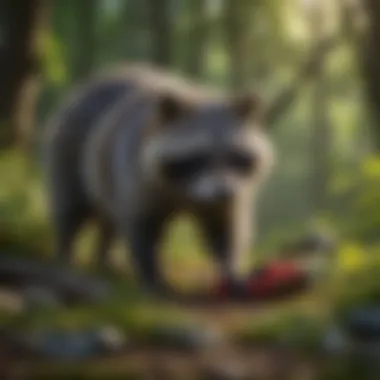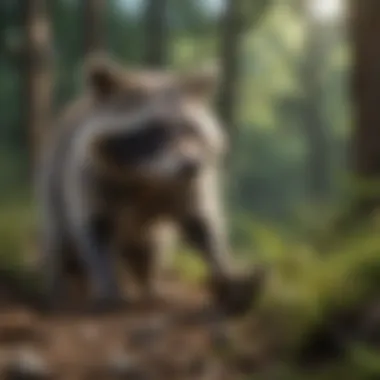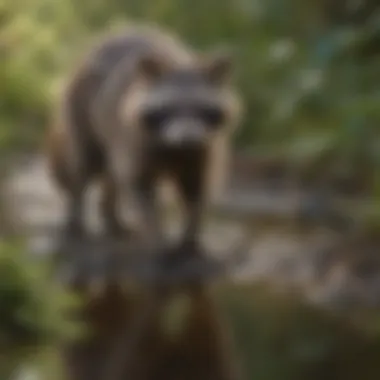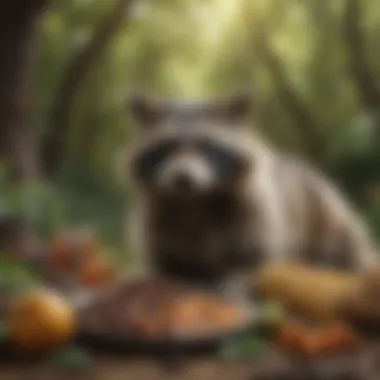Unveiling the Intriguing Eating Habits of Raccoons in Their Natural Environment


Nature Topic Overview
Raccoons, with their masked faces and nimble paws, are intriguing creatures known for their diverse dietary habits. This section will delve into the eating behaviors of raccoons, shedding light on their consumption patterns and the factors influencing their food choices.
Fun Facts and Trivia
Did you know that raccoons have incredibly sensitive hands, allowing them to easily manipulate food and objects? These clever critters are also adept at problem-solving and can remember the solution to a task for up to three years. Children will be fascinated to learn about these intelligent traits through fun visuals and interactive elements in this section.
Wildlife Explorations
Exploring the natural world of raccoons opens up a realm of fascinating discoveries. From understanding their cohabitation with other species to uncovering the plants integral to their ecosystem, this section will provide insight into the interconnected web of wildlife within raccoons' habitats. Engaging quizzes and puzzles will further enhance children's learning experience.
Environmental Awareness
As stewards of our environment, it's crucial to recognize the impact of human activities on raccoon habitats. This section will highlight the importance of conservation efforts and sustainable practices aimed at preserving these creatures' ecosystems. Practical tips for children to contribute to nature's protection will empower young readers to take an active role in environmental preservation.
DIY Nature Activities
Encourage hands-on engagement with nature through a series of DIY activities tailored for children. From creating raccoon-themed crafts to embarking on outdoor explorations inspired by their eating habits, young learners will have the opportunity to deepen their understanding of raccoons while fostering a connection to the natural world.
Introduction
In the vast tapestry of nature, one creature stands out for its adaptability and intriguing dietary habits: the raccoon. These masked bandits have long piqued the curiosity of researchers and enthusiasts alike due to their eclectic taste in food. By delving into the eating habits of raccoons, we can unravel a story of survival, evolution, and ecological importance. Let us embark on a journey to explore the culinary world of these enigmatic creatures.
Understanding Raccoons
Physical Characteristics
One of the most striking features of raccoons is their unique appearance, characterized by their distinctive facial mask and ringed tail. These physical attributes play a crucial role in their survival, enabling them to blend seamlessly into their surroundings and evade potential threats. The coloring of their fur provides excellent camouflage in various habitats, showcasing how evolution has favored their adaptability. However, these same features also make them more susceptible to human fascination and interference, posing challenges to their natural behavior patterns.
Behavioral Traits
Beyond their physical attributes, raccoons exhibit a range of behavioral traits that set them apart in the animal kingdom. Their intelligence and dexterity are noteworthy, allowing them to interact with their environment in sophisticated ways. Raccoons are opportunistic feeders, utilizing their sharp memory and adaptive skills to navigate changing food sources. Their ability to problem-solve and exhibit curiosity highlights their cognitive prowess, making them intriguing subjects for behavioral studies.
Importance of Studying Eating Habits
Ecosystem Impact
Examining the eating habits of raccoons offers valuable insights into their role within ecosystems. By understanding what raccoons consume and how it influences their environment, we gain a deeper appreciation for the intricate web of life. Raccoons' dietary preferences can impact plant and animal populations, affecting biodiversity and ecosystem health. Studying their feeding habits aids in conservation efforts and ecosystem management, ensuring a balanced coexistence between wildlife and their habitats.


Survival Strategies
Survival in the wild is a constant challenge, particularly for omnivores like raccoons that rely on a varied diet. By investigating their survival strategies, we uncover adaptive behaviors honed through generations. From efficient foraging techniques to resourceful food acquisition methods, raccoons have developed a suite of strategies to thrive in diverse environments. Exploring these tactics not only sheds light on raccoons' resilience but also offers lessons in sustainable living and natural resource utilization for human observers.
Raccoons' Diet
Raccoons' diet plays a pivotal role in understanding the eating habits of these fascinating creatures. Their dietary choices have a significant impact on their survival and behavior in the wild. By unraveling the components of a raccoon's diet, we gain insights into their nutritional requirements, foraging behaviors, and ecosystem interactions. Exploring the nuances of what raccoons consume sheds light on their adaptive strategies in varying environments and seasons.
Fruits and Berries
When it comes to fruits and berries, raccoons exhibit a diverse palate, consuming a wide variety of fruits found in their habitat. The variety in consumption allows raccoons to procure essential nutrients and vitamins crucial for their overall health and well-being. Raccoons' affinity for fruits and berries showcases their adaptability to fluctuating food availability and their ability to thrive on a plant-based diet. The nutritional value of these fruits provides raccoons with energy sources and dietary richness necessary for their survival.
Variety in Consumption
The variety in consumption refers to the range of fruits and berries that raccoons include in their diet. This diverse selection not only offers different flavors but also ensures that raccoons obtain a broad spectrum of nutrients. By consuming various fruits and berries, raccoons can balance their nutritional intake and adapt to seasonal changes in food availability. However, this extensive variety may also pose challenges in terms of finding specific fruits at different times of the year, influencing raccoons' foraging patterns.
Nutritional Value
The nutritional value of fruits and berries lies in the essential vitamins, minerals, and antioxidants they provide raccoons. These components contribute to the raccoons' overall health, aiding in growth, reproduction, and immune system function. The abundance of nutrients in fruits and berries enhances raccoons' vitality and ensures their well-being in the dynamic environments they inhabit. Despite the numerous benefits, reliance on fruits and berries may create dependencies that impact raccoons' adaptability during food shortages or changes in fruit availability.
Insects and Invertebrates
Insects and invertebrates are another vital component of a raccoon's diet, offering a protein-rich food source that complements their fruit consumption. Raccoons' foraging techniques when hunting for insects demonstrate their agility and strategic hunting skills. Their dietary preferences for insects and invertebrates reveal a carnivorous aspect of their omnivorous diet, balancing plant-based and animal-derived nutrients.
Foraging Techniques
The foraging techniques employed by raccoons highlight their resourcefulness and agility in locating and capturing insects and invertebrates. Raccoons utilize their keen sense of smell and nimble paws to extract these protein-rich snacks from various hidden locations. The foraging process requires patience and precision, ensuring raccoons secure an ample supply of insects to supplement their dietary requirements. However, this hunting behavior also exposes raccoons to potential risks from larger predators or competition from other foraging animals.
Dietary Preferences
Raccoons exhibit particular preferences when it comes to consuming insects and invertebrates, showing favoritism towards certain types based on taste and availability. These dietary preferences influence their foraging behavior, guiding raccoons to specific habitats or hunting grounds rich in preferred insect species. By understanding raccoons' dietary inclinations towards particular insects, researchers can decipher the intricacies of their nutritional needs and behavioral adaptations. However, such preferences may limit raccoons' diet diversity and pose challenges during seasonal fluctuations in insect populations.
Small Mammals and Birds
The inclusion of small mammals and birds in a raccoon's diet showcases their predatory nature and hunting abilities. Raccoons' hunting behavior towards these animals underscores their position as carnivorous opportunists, blending both plant and animal-based foods in their diet. Understanding the dynamics of how raccoons hunt small mammals and birds provides insight into their predatory instincts and ecological role as predators within their habitats.
Hunting Behavior
Raccoons' hunting behavior towards small mammals and birds involves stealthy approaches and precise strikes to capture prey efficiently. Their agility and sharp claws aid in hunting down these fast-moving targets, demonstrating raccoons' skill in balancing between hunting strategies and energy expenditure. The hunting behavior also reflects raccoons' adaptability to different prey sizes and behaviors, showcasing their versatility in securing animal-based food sources.


Predation Patterns
The predation patterns observed in raccoons reveal their selective predation on certain small mammal and bird species within their ecosystem. By studying these patterns, researchers can gain insights into raccoons' hunting preferences, seasonal variations in predation rates, and the ecological impact of their predation on local wildlife populations. Understanding how raccoons interact with small mammals and birds elucidates the delicate balance between predator and prey dynamics in natural ecosystems, highlighting the role raccoons play in regulating local animal populations.
Human Interaction
The interaction between raccoons and humans poses unique challenges and opportunities, influencing raccoons' dietary behaviors and adaptation strategies in urban settings. Raccoons' ability to adapt to urban environments showcases their resilience and flexibility in exploiting newfound food sources. However, conflicts arising from shared resources between raccoons and humans underscore the need for sustainable cohabitation strategies that ensure the well-being of both species.
Urban Adaptation
Raccoons' urban adaptation skills enable them to navigate human-altered landscapes and infrastructure effectively, finding food sources amidst urban developments. Their ability to thrive in urban environments showcases their adaptability and intelligence in utilizing human-provided resources to meet their dietary needs. The urban adaptation of raccoons highlights the complexity of human-wildlife interactions, raising questions about habitat encroachment, food availability, and ecological implications in urbanized settings.
Food Source Conflicts
Food source conflicts between raccoons and humans arise due to competition for resources such as garbage, pet food, or backyard gardens. These conflicts highlight the challenges of shared spaces between human populations and wildlife, requiring collaborative solutions to mitigate negative interactions. By addressing food source conflicts proactively, communities can foster harmonious relationships with raccoons, instilling responsible behaviors to enhance coexistence and minimize potential conflicts.
Seasonal Variation
Spring and Summer Diet
Feeding Patterns
A pivotal component of the raccoons' spring and summer diet revolves around their distinctive feeding patterns. Raccoons, during these seasons, exhibit heightened activity levels as they consume a wide array of fruits, berries, and insects. The feeding patterns of raccoons in spring and summer reflect their opportunistic nature, enabling them to capitalize on the abundance of food resources during these warmer months. This dietary variety not only sustains the raccoon population but also contributes to the dispersal of seeds and maintenance of ecosystem balance.
Availability of Food
The availability of food during spring and summer plays a critical role in shaping raccoons' dietary choices. As the environment teems with fruits, berries, and insects during these seasons, raccoons have ample opportunities to fulfill their dietary needs. The ready availability of food sources not only supports the raccoons' nutritional requirements but also enhances their overall foraging efficiency. Relying on the abundance of food in spring and summer, raccoons optimize their feeding strategies to maximize resource utilization and energy gain.
Fall and Winter Diet
Food Storage Strategies
Transitioning into fall and winter, raccoons employ unique food storage strategies to adapt to the changing landscape. During these colder months, when food sources become scarce, raccoons exhibit behaviors such as caching food items and creating food stores to sustain themselves during lean times. The meticulous food storage strategies of raccoons serve as a vital survival mechanism, ensuring they have access to sustenance even when natural food availability diminishes.
Survival During Scarcity
Survival during scarcity is a key component of raccoons' fall and winter diet survival strategies. As food becomes increasingly scarce in the colder months, raccoons rely on their stored food supplies and metabolic adaptations to endure periods of scarcity. Their ability to regulate metabolism, conserve energy, and efficiently utilize stored reserves enables raccoons to navigate the challenges of winter fasting and food scarcity. By studying how raccoons survive periods of food scarcity, researchers gain insights into the adaptive mechanisms that allow these creatures to thrive in diverse environmental conditions.
Feeding Behavior


Feeding behavior plays a crucial role in understanding the dietary habits of raccoons. By delving into the ways raccoons acquire food, we can uncover essential elements of their survival strategies. The examination of feeding behavior provides insights into how these creatures navigate their environment to meet their nutritional needs. Understanding their foraging patterns and dietary preferences is vital for comprehending the ecology of raccoons.
Nocturnal Feeding Habits
Adaptations for Night Feeding
The adaptations for night feeding among raccoons are remarkable. Their keen senses, particularly exceptional night vision and acute sense of hearing, enable them to locate food in dim light conditions. Raccoons possess a unique reflective layer in their eyes, enhancing their ability to see in darkness. This adaptation empowers them to efficiently hunt and scavenge during the night, maximizing their chances of securing sustenance.
Stealthy Approach
Raccoons' stealthy approach during nocturnal feeding is a key survival strategy. Their agility, silent movements, and ability to blend seamlessly with the darkness aid in evading potential predators. Adopting a stealthy approach also enhances their hunting success rate by allowing them to surprise unsuspecting prey. This methodical and quiet behavior positions raccoons as proficient nocturnal foragers, ensuring their access to a diverse range of food sources.
Scavenging Instincts
Raccoons' scavenging instincts contribute significantly to ecosystem cleaning. By consuming carrion and organic debris, raccoons play a vital role in recycling nutrients within their environment. This scavenging behavior helps prevent the spread of diseases by removing decaying matter. Additionally, raccoons' consumption preferences for varied food items aid in maintaining a balanced ecosystem by controlling certain populations and ensuring resource utilization remains sustainable.
Role in Ecosystem Cleaning
The role of raccoons in ecosystem cleaning cannot be understated. Their scavenging habits help prevent the accumulation of waste in the environment, contributing to overall cleanliness and hygiene. The consumption of carcasses and organic waste by raccoons promotes nutrient cycling, fostering a healthier ecosystem. Their diligent scavenging not only benefits their own survival but also supports the ecological balance of their habitat.
Consumption Preferences
Raccoons' consumption preferences reflect their adaptable nature. With a diet encompassing a wide array of food items, including fruits, insects, small mammals, and more, raccoons demonstrate flexibility in their feeding habits. Their eclectic food choices enable them to thrive in various environments and utilize available resources efficiently. By being opportunistic feeders, raccoons showcase a resilience that underscores their importance in maintaining biodiversity within their ecosystem.
Conclusion
In encapsulating the study of raccoons' eating habits, it becomes evident that these omnivorous creatures play a crucial role in their ecosystem. By examining the intricacies of raccoons' diet, researchers and enthusiasts gain a deeper understanding of how these animals contribute to the delicate balance of nature. Through their consumption patterns and hunting techniques, raccoons showcase a harmonious blend of adaptation and survival strategies that warrants further exploration.
Ecological Significance
Balancing Predation
Balancing predation is a fundamental aspect of raccoons' role in the ecosystem. These creatures maintain ecological equilibrium by preying on certain species, thereby avoiding overpopulation within their habitats. The strategic hunting behaviors of raccoons help regulate the population dynamics of their prey, preventing potential imbalances that could lead to negative cascading effects on the environment. Although predation may seem harsh, it serves as a natural mechanism for sustaining biodiversity and promoting ecosystem health.
Resource Utilization
Resource utilization is another critical element of raccoons' ecological significance. These animals exhibit a remarkable ability to make use of various food sources efficiently. By capitalizing on fruits, insects, and other available resources, raccoons demonstrate a sustainable approach to nourishment within their environment. This adaptability not only ensures their own survival but also contributes to the overall resilience of the ecosystem. Raccoons' adept utilization of resources underscores the importance of balanced consumption patterns in maintaining a healthy and thriving ecosystem.
Future Research Directions
Technological Innovations
The integration of technological innovations in studying raccoons' eating habits opens up exciting possibilities for future research. Advanced tracking devices and monitoring technologies allow researchers to gather valuable data on raccoons' feeding behaviors and movement patterns with unprecedented precision. By leveraging these innovations, scientists can deepen their knowledge of raccoons' dietary preferences and foraging strategies, paving the way for enhanced conservation initiatives and ecosystem management practices.
Conservation Strategies
Conservation strategies play a pivotal role in safeguarding the well-being of raccoons and their habitats. Implementing conservation measures such as habitat preservation, wildlife corridors, and community education programs can help mitigate human-wildlife conflicts and ensure the long-term sustainability of raccoon populations. By promoting coexistence between humans and raccoons through thoughtful conservation strategies, we can uphold biodiversity, preserve natural ecosystems, and foster a harmonious relationship with these captivating creatures.







